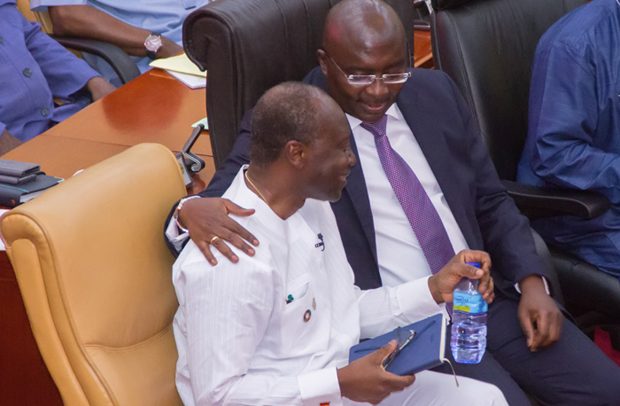Vice President Dr. Mahamudu Bawumia with Finance Minister, Ken Ofori Atta in the Parliament yesterday
The government has devoted $2 billion in the 2019 Budget to the development of infrastructural projects across the country to free up the country’s economy and bring hope and prosperity to Ghanaians.
The government is hoping to spend GH¢73.4 billion in the 2019 fiscal year in the budget christened, ‘Mpomtuo’ (development).
The Finance Minister, Ken Ofori-Atta, who disclosed this yesterday in Parliament during the presentation of government’s 2019 Budget Statement and Economic Policy, said the huge investment to improve the country’s infrastructure – both soft and hard – is unprecedented in the history of the Fourth Republic.
The finance minister said the government had targeted a total revenue of GH¢58.9 billion in 2019 while its total expenditure had been pegged at GH¢73.4 billion, including the clearance of all outstanding arrears.
The government would also use GH¢19.4 billion to pay wages and salaries in 2019, with capital expenditure moving to GH¢8.5 billion, which is 55 per cent over last year’s capital expenditure.
Mr. Ofori-Atta said after 22 months of strengthening the economic fundamentals of the country, the New Patriotic Party (NPP) government is ready to move Ghana to the ‘Canaanland,’ having inherited a messy and tattered economy from the previous National Democratic Congress (NDC).

“The government is committed to embarking on an integrated infrastructural development programme across the country that will move goods, food items and people from one location to another that will create jobs and prosperity and ensure value for money for Ghana, as well as position Ghana as transportation, energy and logistics hub in the sub-region,” the minister said.
The minister explained that since infrastructure is the backbone of economic development, traditional infrastructure like roads, highways, electricity, water, sanitation, bridges and logistics have combined in a rapidly changing global marketplace with new mostly soft infrastructure like digitization of government services to enable emerging economy like Ghana to leapfrog the development path to prosperity.

The minister declared that cabinet would soon submit a bill to parliament for approval that would set up the Ghana Asset Management Corporation for the effective management of those infrastructure projects to be unleashed on the economy.
He mentioned some of the road projects to be undertaken across the country as the Anhwiankwanta-Obuasi Road, Datano-Anokwaa-Suhenso Road, Nyinahin- Awieso Road, Nyinahin-Kyekyewere Road, Okomfo-Anokye-Abuakwa Road, Kumasi City Inner City Roads, including those at Suame, Tafo Pankrono, Asokwa, Kwadaso, Oforikrom, Bantama and Nhyiaeso, as well as Suame and Oforikrom Interchanges, all in the Ashanti Region.
Others are the Atebubu-Kwame Danso Road, Kojokrom-Riverside Road, Sunyani inner city roads, Berekum inner city roads, Tepu-Bomaa-Yamfo Road, Duayaw Nkwanta roads, Oduamse-Seikwa Nkwanta Road all in the Brong Ahafo Region; Kwabeng-Abomosu-Asuom, Kwabeng-Akropong, New Abirem-Ofoase-Akim Oda Road, Akroso-Asamankese Road, and Akim Ankaase Rown Roads and Koforidua Interchange all in the Eastern Region: Asankragwa-Agona-Sefwi Bekwai Road, Benchima-Adwofia Road and Prestea inner city roads all in the Western Region; Twifo-Praso-Dunkwa-On-Offin Road, Akotokyi Road, Ankamu-Achiase-Swedru Road, Swedru-Bawjiase-Adieso Road, Agona Swedru inner city roads and Cape Coast inner city roads, all in the Central Region; Nalerigu-Bunkpurugu Road, Tamale-Salaga-Bimbilla Road, Yendi-Tatale Road, Karaga-Gushegu Road and the Tamale Interchange all in the Northern Region; Wlulungu-Kpasenpke-Wa Raod linking the Northern Region to the Upper West Region, Lawra-Ham-Tumu and Lawra-Dikpe Bridge all in the Upper West Region; Tutulegu-Sandema-Wiase Road and Navrongo-Naga Road, as well as the Bolgatanga-Bawku Road all in the Upper East Region; Jasikan-Dodi-Pepasu-Nkwanta Road and Have-Hohoe-Ho Road, as well as Hohoe inner city roads all in the Volta Region.

The finance minister said the dualisation of the Accra-Kumasi Highway and the Accra-Takoradi Highway would be undertaken while the almighty Accra-Tema Motorway would also be constructed together with most deplorable roads in the capital city of Accra.
He said the railway sector would have its share of investment with the 596-kilometre railway line from Kumasi to Paga high on the agenda.
He said approval had also been given for the construction of new terminal buildings at the Tamale International Airport which would serve the Sahelian region.
The minister indicated that in addition to the massive road infrastructural projects, the government had also committed a whopping $1 billion to the industrialization drive of the country with the ‘One District, One Factory’ taking the centre stage to provide jobs and improve the income levels of many Ghanaians.
The minister announced that there was an unplanned expenditure of over GH¢9 billion to bail out seven banks which were on the brink of insolvency as a result of the bad financial management of the previous government in order to save 2,661 jobs.
He added the money could have been used to invest in infrastructural projects.

He said NPP government had provided more than 100,000 jobs for unemployed graduates through the Nations Buiders’ Corps (NACOB), while many others had been employed under the ‘Planting for Food and Jobs,’ programme.
He also announced that the government had so far paid GH¢502 million to 79,708 DKM customers following the revocation of the licence of that macro finance company by the previous NDC government in February, 2016.
According to him, the Bank of Ghana (BoG) has set aside funds to pay the remaining depositors upon validation, adding that the government would do everything possible to settle the rest of the depositors of DKM.
He assured the House that the government has funds to sustain the free SHS programme, which has so far benefitted 271,000 students across the country and helped many parents to save those monies that would have otherwise been spent on the education of their children and wards.
By Thomas Fosu Jnr


